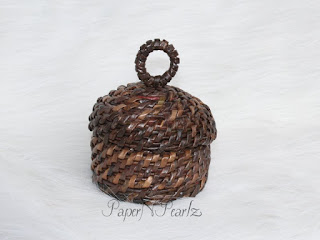When I had posted
these masu boxes earlier, a friend of my mother's, a very creative lady herself, had remarked on my
Facebook page that these boxes very amazingly beautiful :) Well, that gave me quite a high! And got me busily working on the tutorial that I had promised in the post.
On an aside - If you have followed my previous tutorials, I usually make them from Google's Picasa's collages. But lucky me, I found a new collage maker called 'Picture Collage Maker Pro'. I found the software remarkably easy to use and am quite fond of this new tutorial! What do you think? Is it better than my previous ones?
Well, to continue with my tutorial, today I will post the one for making the actual masu box. It is relatively simple and can be done in 10 minutes, tops.
Time Required: ~10 minutes
Difficulty Level: Simple
What is needed:
- 2 squares of paper, both measuring around 8 inches.
- Pencil or pen to make some markings
- Paper clips
- Glue
How to Fold:
1. I am using paper coloured on a single side, yellow for the base and green for the lid.
2. Well, the yellow will be the one in this tutorial.
3. Flip the paper over so that the white side is facing up.
4. Fold along the diagonal and pinch the centre. Don't crease the entire diagonal. You are just trying to find a centre point.
5. Open. Fold along the other diagonal and again, pinch the centre.
6. The two pinches from Steps 4 and 5 should have intersected at the centre. I have marked it with 2 perpendicular lines. You can mark it with a pencil if it isn't very clear.
7. Fold the 4 corners to these markings and crease well.
8. Unfold 2 opposite flaps.
9. Fold the folded edge to the centre as shown.
10. Repeat for the opposite flap.
11. Open up fully and turn it over so that the coloured sided faces you.
12. Fold in half so that one edge meets the other but don't crease fully. Only crease from the edges till you hit the creases made in Steps 9 and 10. Repeat for the other edge.
13. Unfold and turn over so that the white side faces you. You have now completed all creases for folding the box!
14. Fold opposite corners to the centre.
15. Lift the 2 sides on existing creases (made in Steps 9 and 10) and push in the the corners on the third side. The paper will naturally fold in on the crease made in Step 12. Use paper clips, if required, to hold in place.
16. Fold it down inside and crease well. You now have 3 sides completed :)
17. Repeat on the opposite side and you are done!
The flaps inside the box can be glued down for a cleaner look. If you wish to do that, please hold on till my next tutorial, cos we need to undo this box a bit, to get the right side for the corresponding lid.



















































